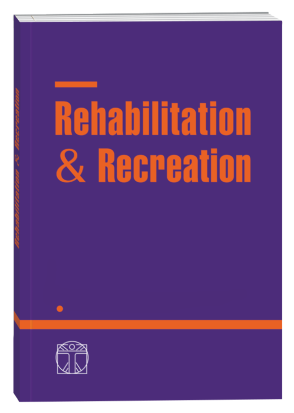THE IMPACT OF YOGA ON THE RESPIRATORY SYSTEM IN 17–18-YEAR-OLD GIRLS
DOI:
https://doi.org/10.32782/2522-1795.2025.19.2.20Keywords:
yoga, breathing exercises, respiratory system, girls aged 17–18 yearsAbstract
Introduction. Current youth are increasingly exposed to various negative factors, including reduced physical activity, elevated stress levels, and a decline in overall physiological function, with a particularly notable impact on the respiratory system. Consequently, identifying effective methods to improve the health of university students remains a pressing concern. Respiratory exercises used in yoga have proven to be an effective means of enhancing overall well-being, increasing physical activity, and promoting adaptation to stress factors while being widely accessible. Objective. To assess the impact of breathing exercises practised during yoga on the functional state of the respiratory system in female students aged 17–18 years. Materials and Methods. The study involved 74 female students divided into two groups: an experimental group (EG, n = 36), which participated in yoga practice, and a control group (CG, n = 38), which followed the standard physical education curriculum. Assessment of respiratory system function included measurements of vital lung capacity (VLC), peak expiratory flow (PEF), forced expiratory volume in one second (FEV1), breath-holding indicators (Stange and Genchi tests), and the calculation of the Skibinski index. Statistical analysis was conducted using Statistica 6.0, with significant differences determined using Student’s t-test, the Mann-Whitney U-test, and the Wilcoxon test. The findings of the research. After eight months of yoga practise, the experimental group (EG) students demonstrated significant improvements in respiratory system parameters. Vital lung capacity (VLC) in the EG increased from 3343±42.88 ml to 3563±41.28 ml (p ≤ 0.05), indicating enhanced ventilatory capacity. A statistically significant improvement was observed in the VLC/non-forced VLC ratio, rising from 88.2±1.66% to 98.4±1.34% (p ≤ 0.05), suggesting an increase in the functional potential of the respiratory system. Breath-holding time in the Shtange test increased to 49.4±0.58 seconds, while in the Genchi test, it rose to 35.1±0.28 seconds (p ≤ 0.05), reflecting greater resistance to hypoxia due to improved tissue oxygenation and the adaptation of chemoreceptors and baroreceptors Conclusions. Regular breathing exercises within yoga practice significantly improves the functional state of the respiratory system in female students. The observed positive changes indicate enhanced adaptive capacity, strengthened respiratory muscles, and increased efficiency of gas exchange. These findings support the inclusion of yoga in physical education programmes as a means of promoting better health among youth.
References
1. Богдановська Н.В., Маліков М.В., Кальонова І.В. Діагностика і моніторинг стану здоров’я : підручник. Запоріжжя : ЗНУ, 2015. 264 с.
2. Боярчук О.Р., Монастирська О.І., Сувалко С.І., Перестюк В.О., Гаріян Т.В. Вплив інфекції SARS-CoV-2, пандемії COVID-19 та повномасштабної війни на здоров’я школярів: результати опитування. Перинатологія і педіатрія. 2024. № 2(98). С. 77–85.
3. Галан Я., Зорій Я. Стратегічні напрями зміцнення психофізичного стану школярів через підвищення рівня рухової активності в умовах соціальних змін та воєнного стану. Physical culture and sport: scientific perspective. 2024. № 1(1). С. 241–246.
4. Клапчук В.В. Використання гігієнічного масажу та респіраторних тренувань в оздоровчій групі жінок молодого віку. Реабілітаційні та фізкультурно-рекреаційні аспекти розвитку людини. 2019. № 4. С. 20–25.
5. Крук М., Ляшевич, А., Чернуха І., Крук А., Левчук Л. Функціональний стан кардіореспіраторної системи організму студентів, що займаються фізичною культурою і спортом. Науковий часопис Українського державного університету імені Михайла Драгоманова. 2020. № 15.3(123). С. 93–97.
6. Ляшенко В., Підвальна О., Булейченко О. Вплив самоізоляції на фізичну активність студентів. Науковий часопис Українського державного університету імені Михайла Драгоманова. 2021. № 15.6(137). С. 82–85.
7. Bijlani R.L., Manjunatha S. Understanding Medical Physiology: A Textbook for Medical Students. 3rd ed. New Delhi: Jaypee Brothers Publishers. 2010. 872 p.
8. Blenkinsop G.M., Pain M.T.G., Hiley M.J. Balance control strategies during perturbed and unperturbed balance in standing and handstand. R. Soc. Open Sci. 2017. 4:61018. https://doi.org/10.1098/rsos.161018
9. Bruce CD., Vanden Berg ER., Pfoh JR., Steinback CD., Day TA. Prior oxygenation, but not chemoreflex responsiveness, determines breath-hold duration during voluntary apnea. Physiol Rep. 2021 Jan; 9(1):e14664. https://doi.org/10.14814/phy2.14664
10. Budhi R.B., Payghan S., Deepeshwar S. Changes in Lung Function Measures Following Bhastrika Pranayama (Bellows Breath) and Running in Healthy Individuals. Int J Yoga. 2019 Sep-Dec;12(3):233–239.
11. Chan S.T., Evans K.C., Song T.Y., Selb J., van der Kouwe A., Rosen B.R., Zheng Y.P., Ahn A, Kwong K.K. Cerebrovascular reactivity assessment with O2-CO2 exchange ratio under brief breath hold challenge. PLoS One. 2020 Mar 24;15(3):e0225915. https://doi.org/10.1371/journal.pone.0225915
12. Divya T.S., Vijayalakshmi M.T., Mini K., Asish K., Pushpalatha M., Suresh V. Cardiopulmonary and metabolic effects of yoga in healthy volunteers. Int J Yoga. 2017;10:115–120.
13. Gumenyuk S., Sereda I., Hulka O., Lavrin H., Ladyka P., Kuz Yu. Effect of yoga on biological age indicators of 14-15-year-old girls. Journal of Physical Education and Sport. 2021. Vol 21 (5). Р. 2956–2962. https://doi.org/10.7752/jpes.2021.s5392
14. Homma I., Phillips AG. Critical roles for breathing in the genesis and modulation of emotional states. Handb Clin Neurol. 2022;188:151–178.
15. Jahan I., Begum M., Akhter S., Islam MZ., Jahan N., Haque M. Effects of alternate nostril breathing exercise on respiratory functions in healthy young adults leading stressful lifestyle. J Popul Ther Clin Pharmacol. 2020 Mar 19;27(1):e104–e114.
16. Jahan I., Begum M., Akhter S., Islam M.Z., Jahan N., Samad N., Das P.A., Rahman N.A., Haque M. Effects of alternate nostril breathing exercise on cardiorespiratory functions in healthy young adults. Ann Afr Med. 2021 Apr-Jun;20(2):69–77.
17. Karthik P.S., Chandrasekhar M., Ambareesha K., Nikhil C. Effect of pranayama and suryanamaskar on pulmonary functions in medical students. J Clin Diagn Res. 2014Dec;8(12):BC04-6.
18. Karunarathne L.J.U, Amarasiri W.A.D.L., Fernando A.D.A. Respiratory function in healthy long-term meditators: A crosssectional comparative study. Heliyon. 2023 Jul 22;9(8):e18585. https://doi.org/10.1016/j.heliyon.2023.e18585
19. Kim S.H., Shin H.J., Cho H.Y. Impact of Types of Breathing on Static Balance Ability in Healthy Adults. Int J Environ Res Public Health. 2022 Jan 21;19(3):1205. https://doi.org/10.3390/ijerph19031205
20. Kothari R., Mittal G, A.P., Bokariya P. Exploring the Effect of Yoga on Exercise Endurance as Assessed by Cardiorespiratory Efficiency Tests in Exercise Physiology Laboratory: A Pilot Study. Cureus. 2023 Apr 29;15(4):e38283. https://doi.org/10.7759/cureus.38283
21. Naik G.S., Gaur G.S., Pal G.K. Effect of modified slow breathing exercise on perceived stress and basal cardiovascular parameters. Int J Yoga. 2018;11:1–4. doi: 10.4103/ijoy.IJOY_41_16
22. Telles S., Singh N., Balkrishna A. Role of respiration in mind-body practices: concepts from contemporary science and traditional yoga texts. Front Psychiatry. 2014 Nov 25;5:167.
23. Rouholah F., Shakerian S., Ghanbarzade M. et al. The comparison of dynamic volumes of pulmonary function between different levels of maximal oxygen uptake. International Research Journal of Applied and Basic Sciences. 2012. 3(3). 667–674.
24. Seltmann C.L., Killen L.G., Green J.M., O'Neal E.K., Swain J.C., Frisbie C.M. Effects of 3 Weeks Yogic Breathing Practice on Ventilation and Running Economy. Int J Exerc Sci. 2020 Feb 1;13(2):62–74. https://doi.org/10.70252/xhag4754
25. Shravya, et al. Immediate effect of suryanadi pranayama on pulmonary function (ventilatory volumes and capacities) in healthy volunteers. Int J Med Res Helath Sci. 2013;2(4):724–29.
26. Skow R.J., Day T.A., Fuller J.E., Bruce C.D., Steinback C.D. The ins and outs of breath holding: simple demonstrations of complex respiratory physiology. Adv. Physiol. Educ. 2015. 39(3). 223–231.
27. Sullivan M.B., Erb M., Schmalzl L., Moonaz S., Noggle Taylor J., Porges S.W. Yoga Therapy and Polyvagal Theory: The Convergence of Traditional Wisdom and Contemporary Neuroscience for Self-Regulation and Resilience. Front Hum Neurosci. 2018 Feb 27;12:67.
28. Taylor A.G., Goehler L.E., Galper D.I., Innes K.E., Bourguignon C. Top-down and bottom-up mechanisms in mind-body medicine: development of an integrative framework for psychophysiological research. Explore (NY). 2010 Jan-Feb; 6(1):29–41. doi: 10.1016/j.explore.2009.10.004.
29. Villemure C., Čeko M., Cotton VA., Bushnell MC. Neuroprotective effects of yoga practice: Age-, experience-, and frequencydependent plasticity. Front Hum Neurosci. 2015;9:1–2.
30. Wendi W., Dongzhe W., Hao W., Yongjin S., Xiaolin G. Effect of dry dynamic apnea on aerobic power in elite rugby athletes: a warm-up method. Front Physiol. 2024 Jan 16;14:1269656. https://doi.org/10.3389/fphys.2023.1269656
31. William E.A., Terry L.D. The effects of respiratory muscles training on VО2max, the ventilaory threshold and pulmonary function. J Exerc Physiol. 2002. 5(2). 29–35.
Downloads
Published
How to Cite
Issue
Section
License

This work is licensed under a Creative Commons Attribution-NonCommercial-NoDerivatives 4.0 International License.





